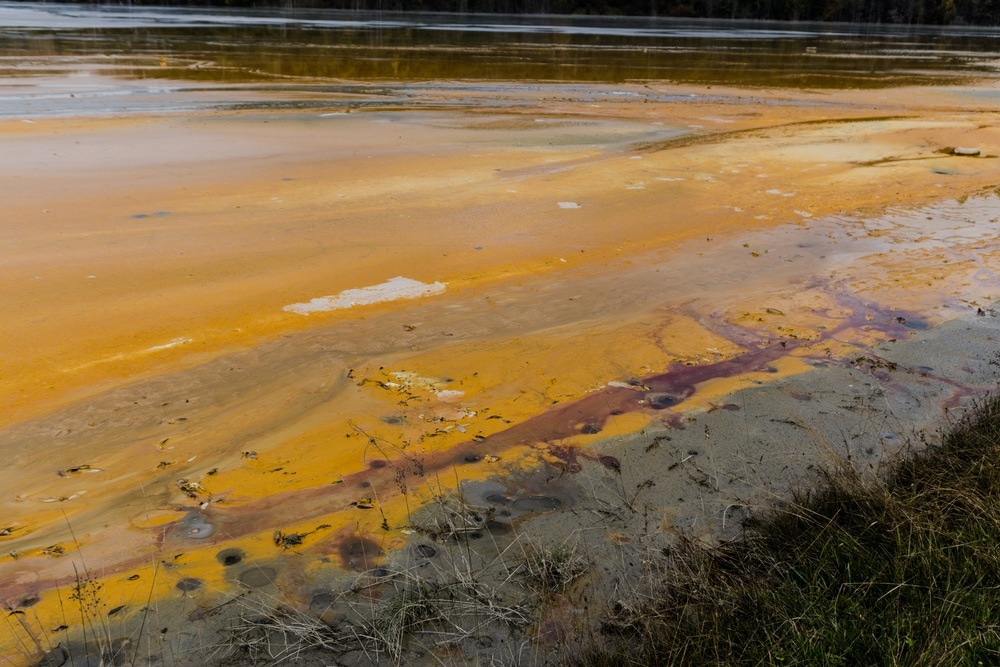
Image credit: Ivmonica/Shutterstock.com
It is extremely common for industrial and mining processes to generate a significant amount of pollution that is discharged into the environment, therefore there is an urgent need to not only reduce the amount of pollutants that are discharged into the environment, but also adequately cleanup areas where these pollutants have travelled to.
Classifying Wastewater from Mining Sites
The main sources of wastewater from mining sites include mine water, process wastewater, domestic wastewater and surface run-ff. The most common contaminants that are produced in a typical mining industry include:
- Physical Contaminants
- Suspended solids (SS): Concentration of solid matter in its suspended form; can vary in size, shape, density and several other factors.
- Turbidity
- Color
- Temperature: Important indicator of biochemical activity (i.e., higher temperatures may result in death of the aquatic organisms)
- Taste
- Odor
- Organic Chemicals
- Coal
- Oils
- Grease
- Soaps
- Detergents
- Rubber
- Dyes
- Phenolic Compounds
- Inorganic Chemicals
- Heavy Metals
- Chromium (Cr)
- Mercury (Hg)
- Copper (Cu)
- Cadmium (Cd)
- Lead (Pb)
- Zinc (Zn)
- Nickel (Ni)
- Acids
- Alkalis
- Cyanide
- Dissolved Salts
- Cations
- Magnesium (Mg)
- Calcium (Ca)
- Potassium (K)
- Sodium (Na)
- Iron (Fe)
- Manganese (Mn)
- Anions
- Chlorine (Cl)
- Sulfate (SO4): Can have a laxative effect on consumer, as well as an unpleasant taste
- Nitrite (NO3)
- Bicarbonate (HCO3)
- Phosphate (PO4): Can lea to eutrophication due to excess plant growth
- Biological Contaminants
- Bacteria
- Viruses
- Small Organisms
- Radiological Contaminants
- Uranium
- Tritium
- Other radioactive substances from mine tailings1
Mining Wastewater Treatment Processes
The development of mining sites in remote locations has caused developers to become even more aware of the impact of large run off streams and their production of metals-laden wastewater, therefore the use of adequate wastewater treatment processes is imperative for any given mining project. A number of companies including Ecologix Environmental Systems, Veolia Water Technologies South Africa and ChemTreat offer mining professionals with a wide variety of wastewater treatment options that specifically target the contaminants generated from any given mine.
Ecologix Environmental Systems
Ecologix offers two types of wastewater treatment systems including the LC-Series Include Plate/TC-Series Tube Clarifiers and Dissolved Air Flotation (DAF) VLT Series Systems.
Clarifiers
Clarifiers are primarily used for removing coarse and heavy contaminants from wastewater produced by mining cites. These clarifiers will typically include an integrated rapid mix tank and floc tank, and as water enters the tank, mixers will agitate the chemicals to create large agglomerations of solids that will eventually settle downward onto a sludge hopper for their final removal2.
Clarifier features include:
- Epoxy Coated Carbon Steel Tank
- Flash/Floc Mixing Tank with Mixers
- Plate Packs
Dissolved Air Flotation (DAF)
This type of mining water treatment system is typically utilized to remove solids, fats, oil and grease by saturating the pressurized water with dissolved air that is eventually discharged into a flotation vessel3. As the microscopic air bubbles of the vessel attach to the solid contaminants present within the waste stream, they will float to the surface and form a blanket of sludge that will eventually be scraped off and pumped into dewatering equipment.
Veolia Water Technologies South Africa
Veolia Water Technologies South Africa offers a number of mine water treatment technologies that are custom made to match the specific requirements of a given mining project. The overall aim of these various treatment systems is to refine the mineral production as well as improve profitability of mining companies, as well as reduce the waste and pollution that mining wastewater can cause to the environment. Some of the technologies offered by Veolia for this purpose include:
- Biological Processes Desalination
- Clarification
- Evaporation
- Crystallization
- Disinfection
- Filtration
- Ion Exchange
- Membrane Separation Package Plants
- Sludge Treatment & Handling Zero Liquid Discharge4
ChemTreat
The experts of ChemTreat ensure mining companies with a maximum recovery and throughput of their water treatment and specialty chemical programs to minimize possible downtime of mining operations, as well as any potential environmental, health and safety risks that can occur during the process.
References
- “Wastewater Characteristics, Management and Reuse in Mining & Mineral Processing Industries” – Encyclopedia of Life Support Systems
- “LC-Series Incline Plate/TC-Series Tube Clarifiers” – Ecologix Environmental Systems
- “Dissolved Air Flotation (DAF) VLT Series Systems” – Ecologix Environmental Systems
- “Mine Water and Wastewater Treatment Solutions” – Veolia Water Technologies
Disclaimer: The views expressed here are those of the author expressed in their private capacity and do not necessarily represent the views of AZoM.com Limited T/A AZoNetwork the owner and operator of this website. This disclaimer forms part of the Terms and conditions of use of this website.